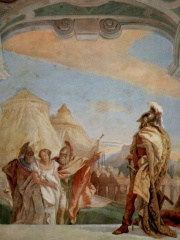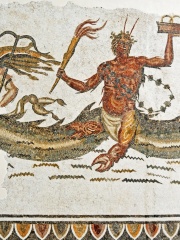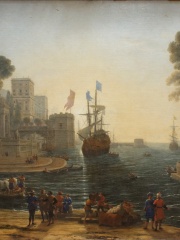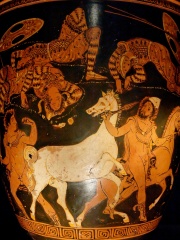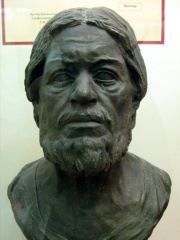
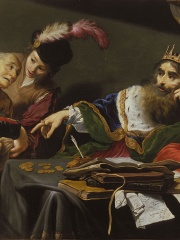
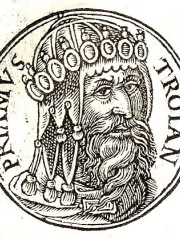
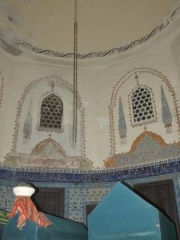
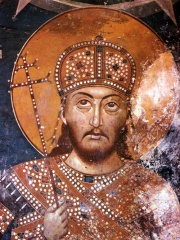
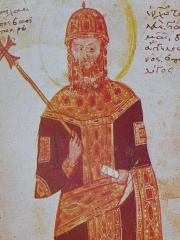
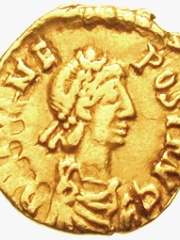

The Most Famous
POLITICIANS from Turkey
This page contains a list of the greatest Turkish Politicians. The pantheon dataset contains 19,576 Politicians, 123 of which were born in Turkey. This makes Turkey the birth place of the 28th most number of Politicians behind Portugal, and Norway.
Top 10
The following people are considered by Pantheon to be the top 10 most legendary Turkish Politicians of all time. This list of famous Turkish Politicians is sorted by HPI (Historical Popularity Index), a metric that aggregates information on a biography’s online popularity. Visit the rankings page to view the entire list of Turkish Politicians.

1. Alp Arslan (1029 - 1072)
With an HPI of 81.74, Alp Arslan is the most famous Turkish Politician. His biography has been translated into 60 different languages on wikipedia.
Alp Arslan, born Muhammad Alp Arslan bin Dawud Chaghri, was the second sultan of the Seljuk Empire and great-grandson of Seljuk, the eponymous founder of the dynasty. He greatly expanded Seljuk territories and consolidated his power, defeating rivals to the south, east and northwest. His victory over the Byzantines at the Battle of Manzikert in 1071 ushered in the Turcoman settlement of Anatolia.

2. Croesus (-596 - -546)
With an HPI of 79.48, Croesus is the 2nd most famous Turkish Politician. His biography has been translated into 62 different languages.
Croesus ( KREE-səs; Phrygian: Akriaewais; Ancient Greek: Κροῖσος, romanized: Kroisos; Latin: Croesus; reigned: c. 585 – c. 546 BC) was the king of Lydia, who reigned from 585 BC until his defeat by the Persian king Cyrus the Great in 547 or 546 BC. According to Herodotus, he reigned 14 years. Croesus was renowned for his wealth; Herodotus and Pausanias noted that his gifts were preserved at Delphi. The fall of Croesus had a profound effect on the Greeks, providing a fixed point in their calendar. "By the fifth century at least", J. A. S. Evans has remarked, "Croesus had become a figure of myth, who stood outside the conventional restraints of chronology."

3. Priam (b. )
With an HPI of 78.40, Priam is the 3rd most famous Turkish Politician. His biography has been translated into 59 different languages.
In Greek mythology, Priam (; Ancient Greek: Πρίαμος, pronounced [prí.amos]) was the legendary and last king of Troy during the Trojan War. He was the son of Laomedon. His many children included notable characters such as Hector, Paris, and Cassandra.

4. Mahidevran (1500 - 1581)
With an HPI of 77.76, Mahidevran is the 4th most famous Turkish Politician. Her biography has been translated into 37 different languages.
Mahidevran Hatun (Ottoman Turkish: ماه دوران, meaning "moon of fortune", died 1581) also known as Gülbahar Hatun, (Ottoman Turkish: کل بھار, meaning "spring rose"), was a concubine of sultan Suleiman the Magnificent and the mother of Şehzade Mustafa of the Ottoman Empire.
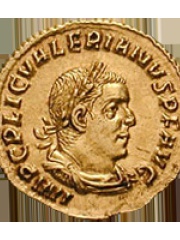
5. Valerian (200 - 260)
With an HPI of 77.04, Valerian is the 5th most famous Turkish Politician. His biography has been translated into 68 different languages.
Valerian ( və-LEER-ee-ən; Latin: Publius Licinius Valerianus; c. 199 – 260 or 264) was Roman emperor from 253 to spring 260 AD. Valerian is known as the first Roman emperor to have been taken captive in battle, captured by the Persian emperor Shapur I after the Battle of Edessa, causing shock and instability throughout the Roman Empire. The unprecedented event and his unknown fate generated a variety of different reactions and "new narratives about the Roman Empire in diverse contexts".

6. Stefan Dušan (1308 - 1355)
With an HPI of 75.75, Stefan Dušan is the 6th most famous Turkish Politician. His biography has been translated into 45 different languages.
Stefan Uroš IV Dušan (Serbian Cyrillic: Стефан Урош IV Душан), also known as Dušan the Mighty (c. 1308 – 20 December 1355), was the King of Serbia from 8 September 1331 and Emperor of the Serbs, Greeks, Bulgarians and Albanians from 16 April 1346 until his death in 1355. Dušan is considered one of the greatest medieval Balkan conquerors. Dušan conquered a large part of southeast Europe, becoming one of the most powerful monarchs of the era. Under Dušan's rule, Serbia was the most powerful state in Southeast Europe and one of the most powerful European states. It was an Eastern Orthodox, multi-ethnic, and multilingual empire that stretched from the Danube in the north to the Gulf of Corinth in the south, with its capital in Skopje. He enacted the constitution of the Serbian Empire, known as Dušan Code, perhaps the most important literary work of medieval Serbia. Dušan promoted the Serbian Church from an archbishopric to a patriarchate, finished the construction of the Visoki Dečani Monastery (now a UNESCO site), and founded the monastery of the Holy Archangels, among others. Under his rule, Serbia reached its territorial, political, economic, and cultural peak. Stefan Dušan worked to forge a coalition with Venice to address the advancing threat of the Ottoman Turks into Europe. However, his efforts were interrupted by his sudden death in December 1355 at his court in Prizren. After his death, the Serbian Empire began to weaken significantly. With the death of Dušan's successor, Emperor Stefan Uroš V, the empire was definitively divided into numerous independent Serbian states, marking what is historically referred to as the Fall of the Serbian Empire. He was originally buried in his foundation near Prizren, but his remains were later relocated to the Church of Saint Mark in Belgrade, where they rest to this day.

7. Michael VIII Palaiologos (1224 - 1282)
With an HPI of 75.40, Michael VIII Palaiologos is the 7th most famous Turkish Politician. His biography has been translated into 53 different languages.
Michael VIII Palaiologos or Palaeologus (Greek: Μιχαὴλ Δούκας Ἄγγελος Κομνηνὸς Παλαιολόγος, romanized: Mikhaēl Doukas Angelos Komnēnos Palaiologos; 1224 – 11 December 1282) reigned as Byzantine emperor from 1261 until his death in 1282, and previously as the co-emperor of the Empire of Nicaea from 1259 to 1261. Michael VIII was the founder of the Palaiologan dynasty that would rule the Byzantine Empire until the Fall of Constantinople in 1453. He recovered Constantinople from the Latin Empire in 1261 and transformed the Empire of Nicaea into a restored Byzantine Empire. His reign saw considerable recovery of Byzantine power, including the enlargement of the Byzantine army and navy. It also included the reconstruction of the city of Constantinople, and the increase of its population. His re-establishment of the University of Constantinople contributed to the Palaeologan Renaissance, a cultural flowering between the 13th and 15th centuries. It was also at this time that the focus of the Byzantine military shifted to the Balkans, against the Bulgarians, leaving the Anatolian frontier neglected. His successors could not compensate for this change of focus, and both the Arsenite schism and two civil wars which occurred from 1321–1328 and 1341–1347 undermined further efforts toward territorial consolidation and recovery, draining the empire's strength, economy, and resources. Regular conflict between Byzantine successor states such as Trebizond, Epirus, Bulgaria and Serbia resulted in permanent fragmentation of former Byzantine territory and opportunity for increasingly successful conquests of expansive territories by post-Seljuk Anatolian beyliks, most notably that of Osman, later called the Ottoman Empire.

8. Julius Nepos (430 - 480)
With an HPI of 74.92, Julius Nepos is the 8th most famous Turkish Politician. His biography has been translated into 66 different languages.
Julius Nepos (died 9 May 480), or simply Nepos, ruled as Roman emperor of the West from 24 June 474 to 28 August 475. After losing power in Italy, Nepos retreated to his home province of Dalmatia, from which he continued to claim the western imperial title, with recognition from the Eastern Roman Empire, until he was murdered in 480. Though Nepos' successor in Italy, Romulus Augustulus (r. 475–476), is traditionally deemed the last western Roman emperor, Nepos is regarded by some historians as the true last emperor of the west, being the last widely recognised holder of the position. A native of Dalmatia, Nepos began his career as the semi-autonomous governor of the province, succeeding his uncle Marcellinus, a prominent general, as magister militum ('master of troops') of Dalmatia. After the death of the western emperor Anthemius (r. 467–472), who had been appointed by the eastern emperor Leo I (r. 457–474), as well as Anthemius' successor Olybrius (r. 472), Leo sought to assert his authority in the west, granting Nepos command of an army in December 473 to attack Italy and depose Glycerius (r. 473–474), who had been proclaimed emperor by the Burgundian general Gundobad. Nepos left for Italy in the spring of 474, backed by Leo's successor Zeno, and landed with his army at Portus, near Rome. Nepos swiftly deposed Glycerius and was crowned western emperor in Rome on 24 June 474. He was the last emperor to be crowned in the city until Charlemagne in the ninth century. Whether the original intention of the invasion was to install Nepos as western emperor is unclear, but in any event, he was quickly recognised as the legitimate western emperor by Zeno. Nepos worked to restore the prestige and authority of the Western Empire, though mostly unsuccessfully. He may have repelled a Visigothic attack on Italy and managed to once more reduce the Burgundians into foederati. Nepos focused most of his attention on reasserting imperial control and authority in Gaul, but the Western Empire could no longer project enough strength to halt Visigothic conquests in the region. The failure to defeat the Visigoths in Gaul, and Zeno's brief overthrow in Constantinople by the usurper Basiliscus, weakened Nepos' already shaky position in Italy. In 475, Nepos' newly appointed magister militum Orestes revolted and marched on Ravenna, capital of the Western Empire. Unable to deal with Orestes' forces, Nepos fled back to Dalmatia and two months later, Orestes proclaimed his young son Romulus Augustulus as emperor. Although no longer in control of Italy, Nepos never renounced his claim to the Western Empire and continued to be recognised as the legitimate western emperor by the Eastern Empire. In 476, the barbarian general Odoacer deposed Romulus Augustulus and became the first king of Italy. Nepos repeatedly petitioned Zeno, who by then had defeated Basiliscus, for help in regaining control of Italy, though all he achieved was nominal recognition by Odoacer, who minted coins in Nepos' name but otherwise mostly ignored him. In 480, Nepos was murdered by two of his generals, Ovida and Viator, perhaps in Diocletian's Palace, possibly while planning an expedition of his own to recover Italy.

9. Balbinus (178 - 238)
With an HPI of 73.71, Balbinus is the 9th most famous Turkish Politician. His biography has been translated into 61 different languages.
Decimus Caelius Calvinus Balbinus (died 238 AD) was Roman emperor with Pupienus for three months in 238, the Year of the Six Emperors.
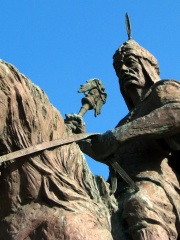
10. Kayqubad I (1188 - 1237)
With an HPI of 73.69, Kayqubad I is the 10th most famous Turkish Politician. His biography has been translated into 32 different languages.
'Alā' ad-Dīn Kay-qubād ibn-e Kay-xusraw (Turkish: I. Alâeddin Keykûbad; Turkish pronunciation: [kejkuːbad], Persian: علاء الدین کیقباد ابن کیخسرو 1190–1237), also known as Kayqubad I, was the Seljuq Sultan of Rûm who reigned from 1220 to 1237. He expanded the borders of the sultanate at the expense of his neighbors, particularly the Mengujek Beylik and the Ayyubids, and established a Seljuq presence on the Mediterranean with his acquisition of the port of Kalon Oros, later renamed Ala'iyya in his honor. The sultan, sometimes styled Kayqubad the Great, is remembered today for his rich architectural legacy and the brilliant court culture that flourished under his reign. Kayqubad's reign represented the apogee of Seljuq power and influence in Anatolia, and Kayqubad himself was considered the most illustrious prince of the dynasty. In the period following the mid-13th century Mongol invasion, inhabitants of Anatolia frequently looked back on his reign as a golden age, while the new rulers of the Anatolian beyliks sought to justify their own authority through pedigrees traced to him.
People
Pantheon has 123 people classified as Turkish politicians born between 1800 BC and 1713. Of these 123, 4 (3.25%) of them are still alive today. The most famous living Turkish politicians include Briseis, Phorcys, and Chryseis. The most famous deceased Turkish politicians include Alp Arslan, Croesus, and Priam.
Living Turkish Politicians
Go to all RankingsDeceased Turkish Politicians
Go to all RankingsAlp Arslan
1029 - 1072
HPI: 81.74
Croesus
596 BC - 546 BC
HPI: 79.48
Priam
HPI: 78.40
Mahidevran
1500 - 1581
HPI: 77.76
Valerian
200 - 260
HPI: 77.04
Stefan Dušan
1308 - 1355
HPI: 75.75
Michael VIII Palaiologos
1224 - 1282
HPI: 75.40
Julius Nepos
430 - 480
HPI: 74.92
Balbinus
178 - 238
HPI: 73.71
Kayqubad I
1188 - 1237
HPI: 73.69
Samuel of Bulgaria
958 - 1014
HPI: 73.67
Alexios III Angelos
1153 - 1211
HPI: 72.48

